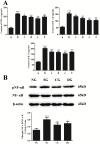1α,25-dihydroxyvitamin D3 ameliorates seawater aspiration-induced acute lung injury via NF-κB and RhoA/Rho kinase pathways
- PMID: 25118599
- PMCID: PMC4132109
- DOI: 10.1371/journal.pone.0104507
1α,25-dihydroxyvitamin D3 ameliorates seawater aspiration-induced acute lung injury via NF-κB and RhoA/Rho kinase pathways
Abstract
Introduction: Inflammation and pulmonary edema are involved in the pathogenesis of seawater aspiration-induced acute lung injury (ALI). Although several studies have reported that 1α,25-Dihydroxyvitamin D3 (calcitriol) suppresses inflammation, it has not been confirmed to be effective in seawater aspiration-induced ALI. Thus, we investigated the effect of calcitriol on seawater aspiration-induced ALI and explored the probable mechanism.
Methods: Male SD rats receiving different doses of calcitriol or not, underwent seawater instillation. Then lung samples were collected at 4 h for analysis. In addition, A549 cells and rat pulmonary microvascular endothelial cells (RPMVECs) were cultured with calcitriol or not and then stimulated with 25% seawater for 40 min. After these treatments, cells samples were collected for analysis.
Results: Results from real-time PCR showed that seawater stimulation up-regulated the expression of vitamin D receptor in lung tissues, A549 cells and RPMVECs. Seawater stimulation also activates NF-κB and RhoA/Rho kinase pathways. However, we found that pretreatment with calcitriol significantly inhibited the activation of NF-κB and RhoA/Rho kinase pathways. Meanwhile, treatment of calcitriol also improved lung histopathologic changes, reduced inflammation, lung edema and vascular leakage.
Conclusions: These results demonstrated that NF-κB and RhoA/Rho kinase pathways are critical in the development of lung inflammation and pulmonary edema and that treatment with calcitriol could ameliorate seawater aspiration-induced ALI, which was probably through the inhibition of NF-κB and RhoA/Rho kinase pathways.
Conflict of interest statement
Figures






Similar articles
-
1α,25-Dihydroxyvitamin D3 Ameliorates Seawater Aspiration-Induced Lung Injury By Inhibiting The Translocation Of NF-κB and RhoA.Inflammation. 2017 Jun;40(3):832-839. doi: 10.1007/s10753-017-0527-3. Inflammation. 2017. PMID: 28161733 Free PMC article.
-
Endothelial Semaphorin 7A promotes inflammation in seawater aspiration-induced acute lung injury.Int J Mol Sci. 2014 Oct 28;15(11):19650-61. doi: 10.3390/ijms151119650. Int J Mol Sci. 2014. PMID: 25353180 Free PMC article.
-
Urinary trypsin inhibitor attenuates seawater-induced acute lung injury by influencing the activities of nuclear factor-ĸB and its related inflammatory mediators.Respiration. 2012;83(4):335-43. doi: 10.1159/000333378. Epub 2011 Dec 14. Respiration. 2012. PMID: 22179035
-
Endothelial semaphorin 7A promotes seawater aspiration-induced acute lung injury through plexin C1 and β1 integrin.Mol Med Rep. 2017 Oct;16(4):4215-4221. doi: 10.3892/mmr.2017.7097. Epub 2017 Jul 27. Mol Med Rep. 2017. PMID: 28765893
-
3,5,4'-Tri-O-acetylresveratrol decreases seawater inhalation-induced acute lung injury by interfering with the NF-κB and i-NOS pathways.Int J Mol Med. 2016 Jan;37(1):165-72. doi: 10.3892/ijmm.2015.2403. Epub 2015 Nov 9. Int J Mol Med. 2016. PMID: 26573555
Cited by
-
Identification of distinct genes associated with seawater aspiration‑induced acute lung injury by gene expression profile analysis.Mol Med Rep. 2016 Oct;14(4):3168-78. doi: 10.3892/mmr.2016.5607. Epub 2016 Aug 9. Mol Med Rep. 2016. PMID: 27509884 Free PMC article.
-
Upregulation of sphingosine kinase 1 contributes to ventilator-associated lung injury in a two-hit model.Int J Mol Med. 2019 Dec;44(6):2077-2090. doi: 10.3892/ijmm.2019.4379. Epub 2019 Oct 21. Int J Mol Med. 2019. PMID: 31638192 Free PMC article.
-
Seawater-drowning-induced acute lung injury: From molecular mechanisms to potential treatments.Exp Ther Med. 2017 Jun;13(6):2591-2598. doi: 10.3892/etm.2017.4302. Epub 2017 Apr 5. Exp Ther Med. 2017. PMID: 28587319 Free PMC article.
-
Erythropoietin Pretreatment Attenuates Seawater Aspiration-Induced Acute Lung Injury in Rats.Inflammation. 2016 Feb;39(1):447-456. doi: 10.1007/s10753-015-0268-0. Inflammation. 2016. PMID: 26454446
-
The Therapeutic Effect and the Possible Mechanism of C-Phycocyanin in Lipopolysaccharide and Seawater-Induced Acute Lung Injury.Drug Des Devel Ther. 2022 Apr 6;16:1025-1040. doi: 10.2147/DDDT.S347772. eCollection 2022. Drug Des Devel Ther. 2022. PMID: 35418745 Free PMC article.
References
-
- Salomez F, Vincent JL (2004) Drowning: a review of epidemiology, pathophysiology, treatment and prevention. Resuscitation 63: 261–268. - PubMed
-
- Ibsen LM, Koch T (2002) Submersion and asphyxial injury. Crit Care Med 30: S402–S408. - PubMed
-
- Xinmin D, Yunyou D, Chaosheng P, Huasong F, Pingkun Z, et al. (2006) Dexamethasone treatment attenuates early seawater instillation-induced acute lung injury in rabbits. Pharmacol Res 53: 372–379. - PubMed
-
- Xie XY, Zhang B, Li JH, Fan QX, Zhang Y, et al. (2011) Sodium tanshinone iia sulfonate attenuates seawater aspiration-induced acute pulmonary edema by up-regulating Na(+),K(+)-ATPase activity. Exp Lung Res 37: 482–491. - PubMed
Publication types
MeSH terms
Substances
LinkOut - more resources
Full Text Sources
Other Literature Sources

